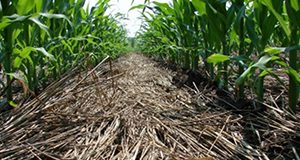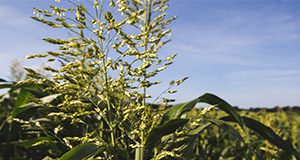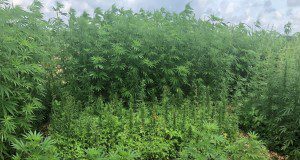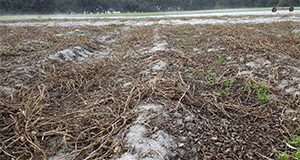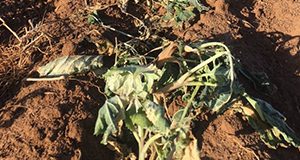When utilizing cover crops for weed suppression, one important consideration is effective termination before planting the main crop. A major issue with improper termination is that the cover crop can become problematic and compete with the main crop, like other weeds. However, proper planning of the termination timing and method can minimize these issues and maximize the benefits of cover crop use. This 5-page publication discusses herbicide application, roller-crimper termination, tillage, and appropriate growth stages for termination. Written by Pratap Devkota, Michael J. Mulvaney, and David Wright, and published by the UF/IFAS Agronomy Department, February 2021.
https://edis.ifas.ufl.edu/ag449
Tag: Michael J. Mulvaney
Boom Sprayer Calibration Tables
This 13-page publication is meant to make calibration of boom sprayers easier, and therefore more common, by providing a convenient chart that can be kept in barns, tractor cabs, sprayers, and mix-load facilities for quick reference. Written by Michael J. Mulvaney, Pratap Devkota, Ethan Carter, De Broughton, and Mark Mauldin, and published by the UF/IFAS Agronomy Department, November 2020.
https://edis.ifas.ufl.edu/ag446
Adjusting Crop Yield to a Standard Moisture Content
Since there are different ways to report moisture (as a decimal or as a percentage), and because the calculation seems intuitive, there is some confusion among agricultural professionals about how to adjust yield to a standardized moisture content. This 4-page publication aims to clarify the concept and the math. Written by Michael J. Mulvaney and Pratap Devkota, and published by the UF/IFAS Agronomy Department, May 2020.
https://edis.ifas.ufl.edu/ag442
Hemp Fertilization: Current Knowledge, Gaps and Efforts in Florida: A 2020 Report
Hemp is an annual herbaceous plant that may be grown for fiber, seed, or flowers. Starting in April 2020, the Florida Department of Agriculture and Consumer Services began accepting applications for cultivation of hemp in Florida, with the potential for building a $20-$30 billion industry in the state. The statewide UF/IFAS Industrial Hemp Pilot Project is researching aspects of agronomic production for hemp cultivation. While a few other state soil testing laboratories provide soil tests and nutrient recommendations based on research and experience, at this time no Florida-specific data on nutrient requirements and fertilization are available. This new 5-page article, written by Rao Mylavarapu, Zachary Brym, Luis Monserrate, and Michael J. Mulvaney and published by the UF/IFAS Department of Soil and Water Sciences, provides a summary of published and personal communications from different states on hemp fertilization.
https://edis.ifas.ufl.edu/ss689
Design and Construction of a Constant Head Infiltrometer
This new 8-page document details the construction procedure for a Mariotte siphon constant head infiltrometer using readily available materials. Written by Mahesh Bashyal, Michael J. Mulvaney, and Eban Z. Bean, and published by the UF/IFAS Agronomy Department, June 2019.
http://edis.ifas.ufl.edu/ag433
Nitrogen Contributions from Peanut Residues to Subsequent Crops
There is not enough evidence to support current peanut N credit recommendations in the Southeast. Nitrogen is released rapidly from peanut residues, and it moves quickly through light-textured soils found in this region. Only a relatively small amount of N from peanut residues is available when subsequent crops need it. This new 5-page document discusses peanut nitrogen credits, nitrogen release from peanut residues, crop performance following peanut, tillage and nitrogen release, and peanut residue distribution and nitrogen release. Written by Arun Jani and Michael J. Mulvaney, and published by the UF/IFAS Agronomy Department, April 2019.
http://edis.ifas.ufl.edu/ag431
Frost Damage of Carinata Grown in the Southeastern US
Brassica carinata is an annual oilseed crop used for the commercial production of jet fuel. One of the challenges to commercialization of this crop in the southeastern United States has been frost damage. This 4-page fact sheet discusses symptomology and ways to minimize risk of frost damage to carinata. Written by Michael J. Mulvaney, Ramdeo Seepaul, Ian Small, David Wright, Silvana Paula-Moraes, Carl Crozier, Paul Cockson, Brian Whipker, and Ramon Leon, and published by the UF/IFAS Agronomy Department, May 2018.
http://edis.ifas.ufl.edu/ag420
AgroClimate Crop Season Planning Tool: Reducing the Risk of Extreme Weather Events During Key Stages of Crop Development
This 5-page publication details a new tool available to growers and Extension professionals to manage risks related to climate during seasonal planning stages. The Crop Season Planning tool is a climate-based tool that enables growers to plan planting strategies that will minimize risk to climate extremes based on historical climate data at their location. Written by Caroline G. Staub, Daniel Perondi, Diego Noleto Luz Pequeno, Patrick Troy, Michael J. Mulvaney, Calvin Perry, Brian Hayes, Willingthon Pavan, and Clyde W. Fraisse, and published by the UF/IFAS Department of Agricultural and Biological Engineering, March 2018.
http://edis.ifas.ufl.edu/ae525
Guide to Olive Tree Nutrition in Florida
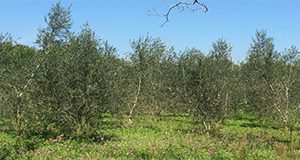 A burgeoning olive industry already exists in the southeastern United States, but research and Extension information regarding olive fertilization recommendations in Florida is limited. While there are data and recommendations for olive from the University of California, the University of Georgia (UGA), and other institutions around the world, there are no data from which we can derive Florida-specific recommendations. This 6-page fact sheet uses many of the existing recommendations for mature, high-density, and traditional grove spacing as guidelines until data specific to Florida production are generated. It discusses leaf tissue sampling procedures, leaf tissue sufficiency ranges, nitrogen fertility, phosphorus and potassium fertility, boron, concerns for olive production in Florida, and other resources for olive production in the state. Written by Michael J. Mulvaney, Rao Mylavarapu, Peter C. Andersen, Mack Thetford, and Jennifer L. Gillett-Kaufman, and published by the UF Agronomy Department, May 2016.
A burgeoning olive industry already exists in the southeastern United States, but research and Extension information regarding olive fertilization recommendations in Florida is limited. While there are data and recommendations for olive from the University of California, the University of Georgia (UGA), and other institutions around the world, there are no data from which we can derive Florida-specific recommendations. This 6-page fact sheet uses many of the existing recommendations for mature, high-density, and traditional grove spacing as guidelines until data specific to Florida production are generated. It discusses leaf tissue sampling procedures, leaf tissue sufficiency ranges, nitrogen fertility, phosphorus and potassium fertility, boron, concerns for olive production in Florida, and other resources for olive production in the state. Written by Michael J. Mulvaney, Rao Mylavarapu, Peter C. Andersen, Mack Thetford, and Jennifer L. Gillett-Kaufman, and published by the UF Agronomy Department, May 2016.
http://edis.ifas.ufl.edu/ag405
Olives for Your Florida Landscape
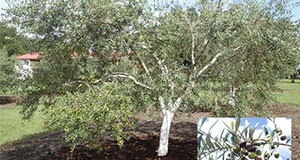 Olives have great potential as a landscape ornamental and may also provide opportunities for home fruit production. However, as a relatively new commercial crop to Florida, the cultural requirements of these trees are not completely known and research is ongoing to understand how to manage them for plant health and fruit yield as well as to make recommendations on varietal selections best suited to the southeastern region of the United States. This 5-page fact sheet includes culture and management information, selected references, and a table listing a selection of olive cultivars currently available in the U.S. Written by Mack Thetford, Jennifer L. Gillett-Kaufman, Michael J. Mulvaney, and published by the UF Department of Environmental Horticulture, February 2015.
Olives have great potential as a landscape ornamental and may also provide opportunities for home fruit production. However, as a relatively new commercial crop to Florida, the cultural requirements of these trees are not completely known and research is ongoing to understand how to manage them for plant health and fruit yield as well as to make recommendations on varietal selections best suited to the southeastern region of the United States. This 5-page fact sheet includes culture and management information, selected references, and a table listing a selection of olive cultivars currently available in the U.S. Written by Mack Thetford, Jennifer L. Gillett-Kaufman, Michael J. Mulvaney, and published by the UF Department of Environmental Horticulture, February 2015.
http://edis.ifas.ufl.edu/ep515
